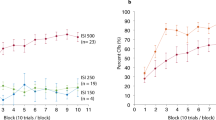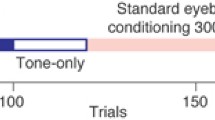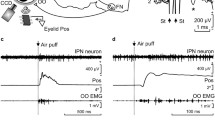Abstract
Blocking is a classical conditioning task in which prior training to one cue such as a tone reduces learning about a second cue such as a light, when subsequently trained as a tone-light compound. Blocking has been theorized to come about through a US-modulated error correction mechanism, by Rescorla & Wagner (1972) as well as through a mechanism of learned inattention as theorized by Mackintosh (1973). In the case of eyeblink conditioning, an error correction mechanism has been hypothesized to take place in the cerebellum while some form of inattention has been hypothesized to take place in the hippocampal region. The hypothesis we., are testing is whether the mechanism of learned inattention is involved in blocking in rabbit eyeblink conditioning. If blocking in eyeblink conditioning is produced by a mechanism of learned inattention, then training to a previously blocked cue should be slower than training to that cue in a naïve animal. Rabbits that had received tone training followed by tone-light training exhibited blocking. Rabbits that had been previously blocked to the light acquired conditioned responses to the light at the same rate as naïve rabbits. This finding failed to support the hypothesis that blocking in rabbit eyeblink conditioning is due to learned inattention, but does support the Rescorla-Wagner mechanism of error correction. The present finding along with previous work on error correction mechanism in the cerebellar-brainstem circuit (Kim et al., 1998) lend support to the theory that blocking, at least in rabbit eyeblink conditioning, seems to be due to an error correction mechanism rather than a learned inattention mechanism.
Similar content being viewed by others
References
Allen, M.T., Chelius, L., & Gluck, M.A. (2002). Selective entorhinal lesions and non-selective cortical-hippocampal region lesions, but not selective hippocampal lesions, disrupt learned irrelevance in rabbit eyeblink conditioning.Cognitive Affective and Behavioral Neuroscience 2. 214–226.
Allen, M.T., Gluck, M.A., & Myers, C.E. (2001). Parallel neural systems for stimulus selection in classical conditioning: support from computational modeling.Integrative Physiological and Behavioral Science. 36(1), 36–61.
Allen, M.T., Myers, C.E., Schnirman, G., Chelius, L., Masand V., & Gluck, M.A. (2002). A comparison of latent inhibition and learned irrelevance pre-exposure effects in rabbit and human eyeblink conditioning.Integrative Physiological and Behavioral Science, 37(3):188–214.
Anderson, B. J., & Steinmetz, J.E. (1994). Cerebellar and brainstem circuits involved in classical eyeblink conditioning.Reviews in Neuroscience, 5(3), 1–23.
Baxter, M.G., Gallagher, M. & Holland, P.C. (1999). Blocking can occur without losses in attention in rats with selective removal of hippocampal cholinergic input.Behavioral Neuroscience. 113. 881–890.
Chan K-H., M. J. R., Jarrard L.E., Davidson T.L. (2001). Reconsideration of the role of the hippocampus in learned inhibition.Behavioral Brain Research, 119, 111–130.
Chen, G. & Steinmetz, J.E. (1998). A general purpose computer system for behavioral conditioning and neural recording experiments.Behavioral Research Methods, Instruments & Computers 30:384–391.
Donegan, N. H., M. A. Gluck, & Thompson, R.F. (1989). Integrating behavioral and biological models of conditioning.Psychology of Learning and Motivation 3, 109–156.
Donegan, N. H. & Wagner, A. R. (1987). Conditioned diminution and facilitation of the UR: A sometimes opponent-process interpretation. Gormezano, I (Ed); Prokasy, W. F. (Ed); (1987).Classical conditioning (3rd ed.). Hillsdale, NJ, USA: Lawrence Erlbaum Associates, Inc.
Douglas, R. J. (1967). The hippocampus and behavior.Psychological Bulletin, 67(6), 416–442.
Douglas, R., & Pribam, K. (1966). Learning and limbic lesions.Neuropsychologia, 4, 192–222.
Gluck, M.A., & Myers, C.E. (1993). Hippocampal mediation of stimulus representation: A computational theory.Hippocampus, 3, 491–516.
Gluck, M.A., Allen, M.T., Myers, C.E., & Thompson, R.F. (2001). Cerebellar substrates for error-correction in motor conditioning.Neurobiology of Learning and Memory. 76, 314–341.
Gluck, M.A., Myers, C.E., & Thompson, R.F. (1994). A computational model of the cerebellum and motor-reflex conditioning.An Introduction to Neural and Electronic Networks. Zornetzer, Davis, Lau and McKenna. New York, Academic Press:91–98.
Holland, P. C. (1997). Brain mechanisms for changes in processing of conditioned stimuli in pavlovian conditioning: implications for behavior study.Animal Learning and Behavior, 25(4), 373–399.
Ison, J.R. & Leonard, D.W. (1971). Effects of auditory stimuli on the amplitude of the nictitating membrane reflex of the rabbit (Oryctolagus cuniculus).Journal of Comparative & Physiological Psychology, 75(1), 157–164.
Kamin, L. (1969). Predictability, surprise, attention and conditioning.Punishment and Aversive Behavior. B. Campbell and R. Church. New York: Appleton.-Century-Crofts:279–296.
Kehoe, E. J. (1982). Overshadowing and summation in compound stimulus conditioning of the rabbit's nictitating membrane response.Journal of Comparative and Physiological Psychology, 8(4), 313–328.
Kim, J.J., Krupa, D.J., & Thompson, R.F. (1998). Inhibitory cerebello-olivary projections and blocking effect in classical conditioning.Science, 279, 570–573.
Kim, J. J., & Thompson, R.F. (1997). Cerebellar circuits and synaptic mechanisms involved in classical eyeblink conditioning.Trends in Neuroscience, 20, 177–181.
Kinkaide, PS. (1974). Stimulus selection in eyelid conditioning in the rabbit (Oryctolagus cuniculus).Journal of Comparative and Physiological Psychology 86:1132–1140.
Kruschke, J.K., & Blair, N.J. (2000). Blocking and backward blocking involve learned inattention.Psychonomic Bulletin & Review. 7, 636–645.
Mackintosh, N. (1973). Stimulus selection: Learning to ignore stimuli that predict no change in reinforcement. In R. Hinde & J. Stevenson-Hinde (Eds.).Constraints on Learning: Limitations and Predispositions (pp. 75–96). New York: Academic Press.
Mackintosh, N. J. (1975). A theory of attention: Variations in the associability of stimuli with reinforcement.Psychological Review, 82, 276–298.
Mackintosh, N. J., & Turner, C. (1971). Blocking as a function of novelty of CS and predictability of UCS.Quarterly Journal of Experimental Psychology, 23, 359–366.
Marchant III, H. G., & Moore, J.W. (1973). Blocking of the rabbit's conditioned nictitating membrane response in kamin's two-stage paradigm.Journal of Experimental Psychology, 101, 153–158.
Martin, I., & Levey, A.B. (1991). Blocking observed in human eyelid conditioning.The Quarterly Journal of Experimental Psychology, 43B, 233–256.
Pearce, J. and G. Hall (1980). “A model for Pavlovian learning: Variations in the effectiveness of conditioned but not of unconditioned stimuli.”Psychological Review 87, 532–552.
Rescorla, R. and A. Wagner (1972). A theory of Pavlovian conditioning: Variations in the effectiveness of reinforcement and non-reinforcement.Classical Conditioning II: Current Research and Theory. A. Black and W. Prokasy. New York, Appleton-Century-Crofts:64–99.
Rogers, R.F., Katz, D.B., Gorin, R.E., & Steinmetz, J.E. (2001). Contextual contributions to the expression of latent inhibition.Society for Neuroscience Abstracts.
Sears, L. L., & Steinmetz, J.E. (1991). Dorsal accessory inferior olive activity diminishes during acquistion of the rabbit classically conditioned eyelid response.Brain Research, 545, 114–122.
Shohamy, D., Allen, M.T., & Gluck, M.A. (2000). Dissociating entorhinal and hippocampal function in latent inhibition.Behavioral Neuroscience. 114, 867–874.
Solomon, P.R. (1977). Role of the hippocampus in blocking and conditioned inhibition of the rabbit's nictitating membrane response.Journal Comparative Physiological Psychology. 91, 407–417.
Solomon, P. R. (1980). A time and place for everything? temporal processing views of hippocampal function with special reference to attention.Physiological Psychology, 8(2), 254–261.
Thompson, L.T., Moyer, J.R., Akase, E., & Disterhoft, J.F. (1994). A system for quantitative analysis of associative learning. Part 1. Hardware interfaces with cross-species applications.Journal of Neuroscience Methods. 54, 109–117.
Author information
Authors and Affiliations
Corresponding author
Rights and permissions
About this article
Cite this article
Allen, M.T., Padilla, Y. & Gluck, M.A. Blocking in rabbit eyeblink conditioning is not due to learned inattention: Indirect support for an error correction mechanism of blocking. Integrative Physiological & Behavioral Science 37, 254–264 (2002). https://doi.org/10.1007/BF02734248
Issue Date:
DOI: https://doi.org/10.1007/BF02734248




